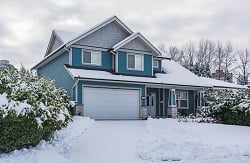
Many people get caught with a leaky roof dilemma in the Winter months. If a leak appears during the Winter, is it best to wait and repair it during the Spring or take action immediately? Leaks can actually cause more damage in the Winter because water continuously freezes and thaws, which can make leaks bigger or even causes new ones. For that reason, it’s recommended that leaky roofs are repaired as soon as possible. To the surprise of many, roofers do work throughout the Winter. While it’s more common to repair roofs during the warmer weather, some roofs are suitable for cold weather repair. Here are roofing materials that can be installed during the Winter, and others that will need to wait until Spring.
Flat Roofs
Not all flat roofing can be installed in the Winter. Polyvinyl Chloride (PVC) and Thermoplastic Olefin (TPO) can be installed in wet and cold weather as they do not rely upon adhesives. PVC and TPO are installed with hot air welding, which is not affected by cold temperatures. Rubber roofs on the other hand can not be installed during the Winter. While some contractors claim they can install them in the cold, this is not best practice. According to manufacturer guidelines, rubber roofs should not be installed in temperatures less than 40 degrees because the adhesive will freeze and inhibit proper bonding. Leaks, cracks, and other problems may arise if rubber roofs are installed during the Winter, and these issues might not be covered by manufacturer's insurance due to improper installation. For this reason, PVC and TPO are suitable for Winter installation, but other flat roofs will need to wait until the Spring.
Sloped Roofs
Typically, roofs installed on homes will be sloped, and the most common materials are asphalt shingles. While asphalt roofs can be installed in the Winter, some extra attention and care will be required. While it’s not an issue if asphalt shingles bend during warm weather installation, in colder temperatures this can cause issues. Asphalt seals through heat from the sun, and that heat bonds layers of shingles together. During the Winter it’s unlikely the shingles will bond completely until warmer temperatures arrive, therefore, it’s important that the shingles are installed completely flush so water doesn’t seep through the cracks and cause leakages. It’s also possible that shingles could blow off the roof during the Winter as they won’t completely bond until the Spring. While asphalt roofs can be repaired in the Winter, there are some drawbacks. Consider the urgency of repairs before moving forward with an asphalt roof installation this Winter.
Metal Roofs
In the Winter, metal is one of the best roof materials to install. The quality is not affected by cold temperatures because metal roofs are designed to combat expansion and contraction. However, the proper installation of underlayment is extremely important. It provides ventilation and also protects from moisture damage, and wherever possible it’s good to install output ventilation as an added precaution. Metal roofs are an all-weather material, so they are perfectly suitable for Winter installation. However, that doesn’t mean roofers want to spend countless hours in the cold to install a roof. Anything that can make their process more efficient and effective is always beneficial, especially during the cold months of Winter. The SCRAIL® Roofloc® System makes metal roofing installation faster than ever. The collated SCRAIL® strips eliminate fastener waste, and have a holding power exceeding 560 lbs. With user friendly features like full sequential trigger actuation and an easy rear-loading magazine, contractors will be able to get roofing repairs done in record time this Winter.
Before you jump to repair that leak, consider the style of roof and the materials involved. While all roofing materials are designed to resist Winters harsh effects, they’re not all designed to be installed when it’s cold. Low temperatures tend to have a negative impact on adhesives and bonding, so be mindful of your repairs. There’s nothing worse than fixing a roof only to have to do it again a few months later.
.svg.png)

